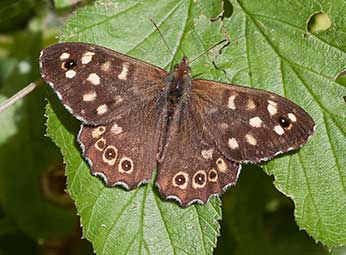Speckled Wood (Pararge aegeria)
When: Mainly early April to mid-May, June and again from early August to early October
How many: Often relatively abundant and widespread

off its attractive wing markings
Speckled Wood butterflies are superbly named examples of our forebears saying what they saw, for both sexes of these attractive creatures are certainly speckled - creamy yellow patches on the upperwings are splashed onto a dark brown background; whilst a number of white centred, black 'eyespots' earned for them the early name Wood Argus, a reference to the many-eyed character of Greek mythology.
And rarely are they seen far away from trees. Indeed, Speckled Woods are likely to be found in shadier places than most other British butterflies, with the possible exception of the White Admiral.
They can be seen on the wing on the dullest of days, although sunlight is not avoided altogether for ever-pugnacious males frequently occupy their own beam of light in which to rest, bask and engage in display flights. Potentially competing males, and even butterflies of other species that stray too close, are unceremoniously chased away or else engaged in spiralling aerial battles. Females, too, will be chased, but with altogether different intentions before, as often as not, the original occupier of the sunbeam returns to its perch to rest, bask and display some more.
Primarily on the wing in April, May and June and again from August to late September or early October, these medium sized butterflies are relatively common and widespread in many New Forest woodlands, just as they are elsewhere in many parts of Hampshire.
Honeydew taken from the treetops is a favourite foodstuff, although Speckled Woods may also be seen nectaring on bramble blossom and other wild flowers. A variety of grasses are used as caterpillar foodplants.
References:
Butterflies of the British Isles: J.A. Thomas
The Butterflies of Hampshire: Matthew Oates, John Taverner, David Green et al
The Millennium Atlas of Butterflies in Britain and Ireland: Jim Asher, Martin Warren, Richard Fox, Paul Harding, Gail Jeffcoate and Stephen Jeffcoate
Insects of the New Forest - Paul Brock
British Butterflies and Moths - W. Furneaux, FRGS
British Butterflies - W.S. Coleman
More links
Other related links
Search this site

Sadly, 58 animals were killed - 35 ponies, 13 cows, 8 donkeys and 2 sheep, whilst a further 32 were injured - 3 pigs, 9 donkeys, 11 cows and 9 ponies.
(Forty-three accidents occurred in daylight, 15 at twilight and 101 in the dark. Twenty-seven accidents were not reported by the driver involved).
Here's just one horrific example - Three donkeys killed in collision with van at notorious New Forest blackspot (Advertiser and Times)

